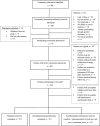Identifying heavy health care users among primary care patients with chronic non-cancer pain
- PMID: 35005339
- PMCID: PMC8730606
- DOI: 10.1080/24740527.2017.1326088
Identifying heavy health care users among primary care patients with chronic non-cancer pain
Abstract
Objective: The objective of this study was to identify biopsychosocial factors predicting primary care chronic non-cancer pain (CNCP) patients' risk of being heavy health care users. Methods: Patients reporting moderate to severe CNCP for at least 6 months with an active analgesic prescription from a primary care physician were recruited in community pharmacies. Recruited patients completed questionnaires documenting biopsychosocial characteristics. Using administrative databases, direct costs were estimated for health care services used by each patient in the year preceding and following the recruitment. Heavy health care users were defined as patients in the highest annual direct health care costs quartile. Logistic multivariate regression models using the Akaike information criterion were developed to identify predictors of heavy health care use. Results: The median annual direct health care cost incurred by heavy health care users (n = 63) was CAD (Canadian dollars) 7627, versus CAD 1554 for standard health care users (n = 188). The final predictive model of the risks of being a heavy health care user included pain located in the lower body (odds ratio [OR] = 3.03; 95% confidence interval [CI], 1.20-7.65), pain-related disability (OR = 1.24; 95% CI, 1.03-1.48), and health care costs incurred in the year prior to recruitment (OR = 17.67; 95% CI, 7.90-39.48). Variables in the model also included sex, comorbidity, patients' depression level, and attitudes toward medical pain cure. Conclusion: Patients suffering from CNCP in the lower body and showing greater disability were more likely to be heavy health care users, even after adjusting for previous-year direct health care costs. Improving pain management for these patients could have positive impacts on health care use and costs.
Objectif: Déterminer les facteurs biopsychosociaux prédictifs du risque d’être un grand utilisateur de services de santé chez les patients souffrant de douleur chronique non cancéreuse (DCNC) suivis en soins de première ligne.Méthodologie: Des patients souffrant d’une DCNC modérée à sévère depuis au moins six mois et bénéficiant d’une ordonnance d’analgésique valide donnée par un médecin de famille ont été recrutés dans des pharmacies communautaires. Les patients recrutés ont ensuite complété des questionnaires documentant leurs caractéristiques biopsychosociales. À l’aide de bases de données administratives, les coûts directs des services de santé utilisés par chaque patient au cours de l’année précédant et suivant son recrutement ont été estimés. Les grands utilisateurs de soins de santé ont été définis comme les patients faisant partie du quartile le plus élevé de coûts directs annuels en soins de santé. Des modèles de régression logistique multivariée utilisant le critère d’information Akaike ont été élaborés afin de déterminer les facteurs prédictifs de grande utilisation des soins de santé.Résultats: Le coût direct annuel médian en soins de santé chez les grands utilisateurs de soins de santé (n = 63) était de 7 627 CAD comparativement à 1 554 CAD pour les utilisateurs de soins de santé réguliers (n = 188). Le modèle prédictif final du risque d’être un grand utilisateur de soins de santé comprenait la douleur au niveau des membres inférieurs (rapport de cotes (RC) = 3,03; intervalle de confiance (IC) à 95 %: 1,20 – 7,65), la réduction de la capacité fonctionnelle liée à la douleur (RC = 1,24; IC à 95 %: 1,03 – 1,48) et les coûts directs en soins de santé au cours de l’année précédant le recrutement (RC = 17,67; IC à 95 %: 7,90 – 39,48). Les variables « sexe », « comorbidité », « dépression » et « attitudes envers la guérison médicale » étaient également retenues dans le modèle.Conclusion: Les patients souffrant de DCNC au niveau des membres inférieurs et présentant une détérioration de la capacité fonctionnelle liée à la douleur étaient plus susceptibles d’être de grands utilisateurs des soins de santé, même après ajustement pour le coût direct en soins de santé pendant l’année précédente. L’amélioration de la prise en charge de la douleur chez ces patients pourrait avoir des répercussions positives sur l’utilisation et le coût des soins de santé.
Keywords: Akaike information criterion; chronic non-cancer pain; predictors of heavy health care use; primary care.
© 2017 Elie Antaky, Lyne Lalonde, Mireille E. Schnitzer, Élisabeth Martin, Djamal Berbiche, Sylvie Perreault, David Lussier, and Manon Choinière. Published with license by Taylor & Francis Group, LLC.
Figures

References
-
- Moulin DE, Clark AJ, Speechley M, Morley-Forster PK.. Chronic pain in Canada—prevalence, treatment, impact and the role of opioid analgesia. Pain Res Manag. 2002;7(4):179–184. - PubMed
-
- Gureje O, Von Korff M, Simon GE, Gater R.. Persistent pain and well-being: a World Health Organization study in primary care. JAMA. 1998;280(2):147–151. - PubMed
-
- Ohayon MM. Relationship between chronic painful physical condition and insomnia. J Psychiatr Res. 2005;39(2):151–159. - PubMed
LinkOut - more resources
Full Text Sources
Other Literature Sources
Miscellaneous
